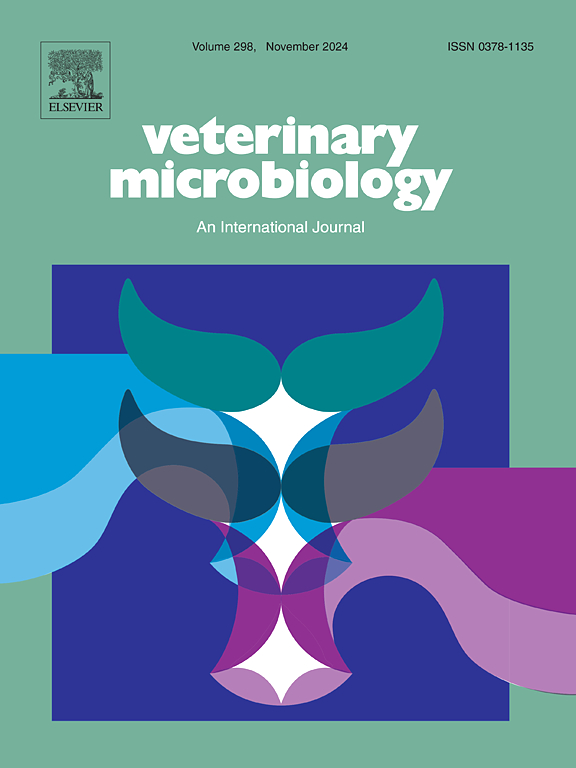Antiviral activity of Stephania japonica extract against porcine epidemic diarrhea virus infection
IF 2.7
2区 农林科学
Q3 MICROBIOLOGY
引用次数: 0
Abstract
Porcine epidemic diarrhea virus (PEDV) is a major cause of diarrhea in piglets, causing substantial economic losses to the global swine industry. At present, no specific antiviral medications are available to treat PEDV infections. Natural compounds, with their wide availability, diverse biological activities, and low toxicity, have emerged as promising candidates for antiviral drug discovery. This study screened eight plant-derived bisbenzylisoquinoline alkaloids, including cepharanthine and tetrandrine, to assess their anti-PEDV activity in vitro. The results demonstrated that cepharanthine extracts significantly reduced viral titers and genome copies, indicating strong anti-PEDV activity. Notably, the botanical extracts exerted antiviral effects at both the initial stage of infection and the late phase of virion release, as evidenced by reduced viral output and suppressed mRNA synthesis. Molecular docking and dynamic analyses revealed that cepharanthine binds to PEDV 3CLpro (Mpro) protease through hydrogen bonds and hydrophobic interactions, forming a stable complex. This interaction likely impairs Mpro function, thereby inhibiting viral replication and the synthesis of related proteins. In vivo experiments further confirmed that piglets treated with cepharanthine extracts exhibited significantly lower viral loads and better preservation of intestinal structure compared to the control group. These findings provide key insights into the antiviral effects of cepharanthine extracts, supporting their potential for further development as anti-PEDV therapies and as a foundation for plant-derived antiviral compound research.
菝葜提取物对猪流行性腹泻病毒感染的抗病毒活性研究
猪流行性腹泻病毒(PEDV)是仔猪腹泻的主要原因,给全球养猪业造成了巨大的经济损失。目前,没有专门的抗病毒药物可用于治疗PEDV感染。天然化合物具有广泛的可得性、多样的生物活性和低毒性,已成为抗病毒药物开发的有希望的候选者。本研究筛选了8种植物源性双苄基异喹啉生物碱,包括头花碱和粉防己碱,以评估其体外抗pedv的活性。结果表明,头孢蒽醌提取物可显著降低病毒滴度和基因组拷贝数,显示出较强的抗pedv活性。值得注意的是,植物提取物在感染初期和病毒粒子释放后期都有抗病毒作用,这可以通过减少病毒输出和抑制mRNA合成来证明。分子对接和动力学分析表明,头孢酞氨酸通过氢键和疏水相互作用与PEDV 3CLpro (Mpro)蛋白酶结合,形成稳定的配合物。这种相互作用可能会损害Mpro的功能,从而抑制病毒复制和相关蛋白的合成。体内实验进一步证实,与对照组相比,经猪天竺蓟素提取物处理的仔猪病毒载量显著降低,肠道结构得到了更好的保存。这些发现为了解头孢酞菁提取物的抗病毒作用提供了关键见解,支持其作为抗pedv疗法的进一步开发潜力,并为植物源性抗病毒化合物的研究奠定了基础。
本文章由计算机程序翻译,如有差异,请以英文原文为准。
求助全文
约1分钟内获得全文
求助全文
来源期刊

Veterinary microbiology
农林科学-兽医学
CiteScore
5.90
自引率
6.10%
发文量
221
审稿时长
52 days
期刊介绍:
Veterinary Microbiology is concerned with microbial (bacterial, fungal, viral) diseases of domesticated vertebrate animals (livestock, companion animals, fur-bearing animals, game, poultry, fish) that supply food, other useful products or companionship. In addition, Microbial diseases of wild animals living in captivity, or as members of the feral fauna will also be considered if the infections are of interest because of their interrelation with humans (zoonoses) and/or domestic animals. Studies of antimicrobial resistance are also included, provided that the results represent a substantial advance in knowledge. Authors are strongly encouraged to read - prior to submission - the Editorials (''Scope or cope'' and ''Scope or cope II'') published previously in the journal. The Editors reserve the right to suggest submission to another journal for those papers which they feel would be more appropriate for consideration by that journal.
Original research papers of high quality and novelty on aspects of control, host response, molecular biology, pathogenesis, prevention, and treatment of microbial diseases of animals are published. Papers dealing primarily with immunology, epidemiology, molecular biology and antiviral or microbial agents will only be considered if they demonstrate a clear impact on a disease. Papers focusing solely on diagnostic techniques (such as another PCR protocol or ELISA) will not be published - focus should be on a microorganism and not on a particular technique. Papers only reporting microbial sequences, transcriptomics data, or proteomics data will not be considered unless the results represent a substantial advance in knowledge.
Drug trial papers will be considered if they have general application or significance. Papers on the identification of microorganisms will also be considered, but detailed taxonomic studies do not fall within the scope of the journal. Case reports will not be published, unless they have general application or contain novel aspects. Papers of geographically limited interest, which repeat what had been established elsewhere will not be considered. The readership of the journal is global.
 求助内容:
求助内容: 应助结果提醒方式:
应助结果提醒方式:


